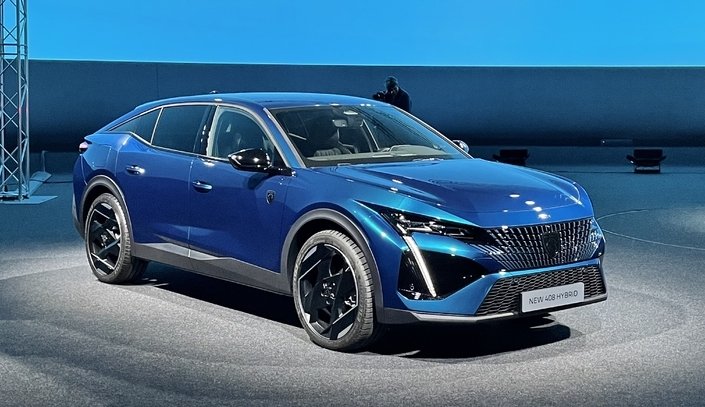2023 Peugeot 408 is striking saloon-SUV to rival VW T-Roc

The 408 is an entirely new model for Peugeot that adds an innovative fastback design to its compact car range, which currently comprises the more conventional Peugeot 308 hatchback and Peugeot 3008 SUV.
Unrelated to the Chinese-market 408 small saloon, the fastback is intended to marry the best of SUVs, hatchbacks and saloons by combining an aerodynamic, coupé-esque silhouette with ample space and good driving dynamics in a relatively compact package.
Due at the start of 2023, the 408 sits on the same EMP2 modular platform as the 308. At 4690mm long and 1480mm tall, it is a significant 440mm longer and almost 40mm higher than the 308. The final product was seven years in the making, because it was considered quite radical at its inception and apparently took some convincing at board level.
Design project manager Pierre-Paul Mattei revealed that giving the car “dynamism without hiding the fact that it’s roomy” was a hurdle.
“A classical fastback – the Peugeot 508, for example – starts to drop the car’s top line at the B-pillar, but here it’s the back of the rear door, which makes rear access and space better,” explained Mattei.
The front grille is reminiscent of the current Peugeot range but modernises it, introducing a vertical body-colour pattern in which the blocks of colour get bigger towards the edges.
Mattei said this new grille plays to the next generation of electrified cars and is likely to be used again in future.
The interior was developed alongside the 308 – “our job was to balance making it the 408 but with the best bits of the 308”, said Mattei. It features Peugeot’s latest i-Cockpit layout, including a digital dial display and a 10.0in infotainment touchscreen with wireless Apple CarPlay and Android Auto, and has extended storage space.
Three powertrains will be offered from launch: two plug-in hybrids, which should match the 308 PHEV’s electric-only range of around 40 miles, and a 128bhp 1.2-litre turbocharged three-cylinder petrol. All are mated to an automatic gearbox. The petrol engine will be replaced with a mild-hybrid unit by the end of 2023 and an electric e-408 will follow, although a date for that isn’t yet confirmed.
Peugeot hopes the 408 will attract new customers to the brand, having positioned it price-wise between the 308 and 3008 (the latter of which starts at £33,225), despite it being closer in length to the 508 saloon.
“Customers might be compact hatchback owners who want more roominess but the same driving experience,” said 408 product manager Aurélie Bresson, “or compact SUV owners looking for a more distinctive car and a more dynamic driving experience, or larger saloon owners looking for modern lines while maintaining a longer car.
“They have in common that they’re open-minded and don’t just buy a car for functionality.”
No threat to the 508
Peugeot positions the 408 as a take on the traditional saloon, rather than an SUV (hence the three-digit rather than four-digit name), but it’s adamant that there’s still a place for the larger 508.
“The 508 does a good job for us,” Peugeot marketing boss Phil York told Autocar.
“It’s an icon for the brand – a high-end product.
“We have the 508 PSE [performance PHEV], which is an interesting proposition in the marketplace, and the 508 SW [estate], which fulfils a specific customer need too.
“We’re very happy with what 508 does for us.”
Data sourced by Autocar reveals that Peugeot sold just over 1200 508s in the UK last year, compared with 12,200 3008s, but York suggested the 508 plays an important role in the fleet market and suggested an “animation in the life cycle” (or facelift) will freshen it up some time soon.
Q&A - Pierre-Paul Mattei, Peugeot 408 Design Project Manager
It has been seven years since this project started. Were you worried the car would arrive out of date?
“The hope was that no one [else] would design this car. It’s a great opportunity for us. We thought: ‘If we see this empty space, maybe other brands will see it.’ We’re glad they didn’t.”
The new 308 and 408 were created in tandem. Why?
“By approaching it this way, we knew which would be the carry-over parts between the 308 and 408, particularly technology such as the front and rear lights. The windshield is in exactly the same position as the 308. We designed the interior for the 408, but it also went in the 308. This was possible because both cars are in the same segment.”
What was the biggest challenge in designing it?
“To give dynamism and elegance to the unusual proportions of this car. We knew that a classical saloon design wouldn’t work. One designer tried it with a 508 silhouette at the rear of the car and quickly realised that! We had to invent a new design language, giving it dynamism without hiding that it’s [spacious inside].”
The rear bumper differs to that of other Peugeots. Why?
“This rear bumper was necessary. Because of it, the car seems narrow when it’s not. It’s actually quite wide. To cut the body colour off with this inverted bumper creates dynamism. Our intention is to be disruptive, and this bumper does that.
